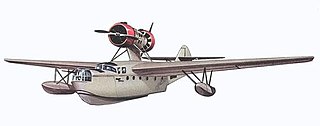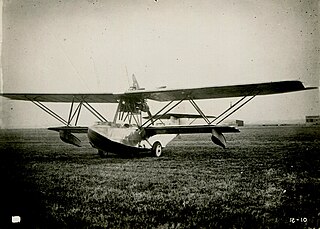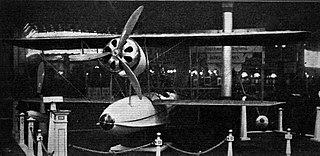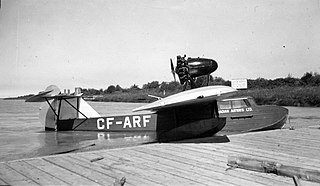
The Martin P5M Marlin, built by the Glenn L. Martin Company of Middle River, Maryland, was a twin piston-engined flying boat that entered service in 1951, and served into the late 1960s with the United States Navy performing naval patrols. It also served with the United States Coast Guard and the French Navy. 285 were produced.

The Curtiss NC was a flying boat built by Curtiss Aeroplane and Motor Company and used by the United States Navy from 1918 through the early 1920s. Ten of these aircraft were built, the most famous of which is the NC-4, the first airplane to make a transatlantic flight. The NC-4 is preserved in the National Museum of Naval Aviation, at NAS Pensacola, Florida.

Between 1911 and 1914, the Royal Aircraft Factory used the F.E.2 designation for three quite different aircraft that shared only a common "Farman" pusher biplane layout.

The Short S.14 Sarafand was a British biplane flying boat built by Short Brothers. It was planned as a general reconnaissance aircraft for military service. When it was built in 1932 it was the largest aeroplane in the United Kingdom.

The Piaggio P.136 was an Italian twin-engine amphibian flying boat designed and manufactured by aircraft company Piaggio Aero. It is furnished with an all-metal hull, pusher propellers, a gull wing, and retractable landing gear.

The Naval Aircraft Factory PN was a series of open cockpit American flying boats of the 1920s and 1930s. A development of the Felixstowe F5L flying boat of the First World War, variants of the PN were built for the United States Navy by Douglas, Keystone and Martin.

The Chyetverikov ARK-3 was a multi-role flying boat designed for Arctic operations that was built in the Soviet Union from 1933. It featured a conventional flying boat hull, with high cantilever wings equipped with floats at mid-span. The two piston engines were mounted in tractor-pusher fashion on a pylon above the fuselage.

The Curtiss HS was a single-engined patrol flying boat built for the United States Navy during World War I. Large numbers were built from 1917 to 1919, with the type being used to carry out anti-submarine patrols from bases in France from June 1918. It remained in use with the US Navy until 1928, and was also widely used as a civil passenger and utility aircraft.

The Dornier Do R Superwal was a German flying boat airliner of the 1920s.

The Loire 102 was a 1930s French flying boat designed as a mail plane by Loire Aviation.

The Fokker B.I was a reconnaissance flying boat built in the Netherlands in 1922. The B.I was followed by an improved version, the B.III in 1926. It was a conventional biplane flying boat design, with staggered sesquiplane wings braced by struts arranged as a Warren truss. The engine was mounted pusher-wise on the top wing. The duralumin hull featured three open cockpits - one at the nose for a gunner, one in front of the lower wing for the pilot and engineer and one behind the wings for another gunner. The B.I was amphibious, equipped with main undercarriage that folded back along the hull, but this feature was omitted in the B.III. The B.I was flown in the Dutch East Indies by the Naval Air Service for a number of years, and although it gave good service, no further examples were ordered from Fokker.

The Fokker F-11 was a luxury flying boat produced as an 'air yacht' in the United States in the late 1920s. Technically the aircraft was the Fokker Aircraft Corporation of America's Model 9. It was sold in North America as the Fokker F-11 and was offered in Europe as the Fokker B.IV. By the time the first six aircraft had been constructed, it was already evident that the design was not going to sell well. A few were sold, two to notable multi-millionaires; Harold Vanderbilt and Garfield Wood each purchasing one. One was bought by Air Ferries in San Francisco. The F-11A cost $40,000 but the price was slashed to $32,500 as the depression set in during 1930. The F-11 was a commercial failure.

The Latécoère 380 was a flying boat aircraft designed and produced by the French aircraft manufacturer Latécoère. It was designed for use on Aéropostale's mail routes to South America, the aircraft subsequently saw military service as a maritime patrol aircraft.

The Latécoère 500 was a flying boat designed and produced by the French aircraft manufacturer Latécoère.

The Zeppelin-Lindau Rs.I was a large three-engined biplane flying boat designed by Claudius Dornier and built during 1914–15 on the German side of Lake Constance. It was destroyed in a storm.

The DAR, was a twin-engined flying boat designed and produced in the USSR from 1934.

The Zeppelin-Lindau Rs.II was a biplane flying boat, designed by Claudius Dornier as a follow-on to his Zeppelin-Lindau Rs.I and built during 1914–1915 on the German side of Lake Constance. Initially this aircraft was powered by three engines mounted inside the hull driving three pusher propellers via gearboxes and shafts. The later version was powered by four engines in two push-pull nacelles mounted between the wings.
The Aeromarine EO was a light sport flying boat that was built in the mid-1920s.

The Pemberton-Billing P.B.1, sometimes known as the Supermarine, was a 1910s British single-seat flying-boat built by Pemberton-Billing Limited, which later became the Supermarine Aviation Works. Only one P.B.1 was built, and it never flew any distance further than a hop.

The Boeing-Canada A-213 Totem was a Canadian single-engine pusher monoplane flying boat intended for forestry and fisheries patrols as well as a light utility transport for the British Columbia coastline, where there are few flat places for runways, and waterways are plentiful. The sole example, CF-ARF, CB10 was designed and built by Boeing Aircraft of Canada. The name refers to the Totem poles used by the First Nations in British Columbia.






















